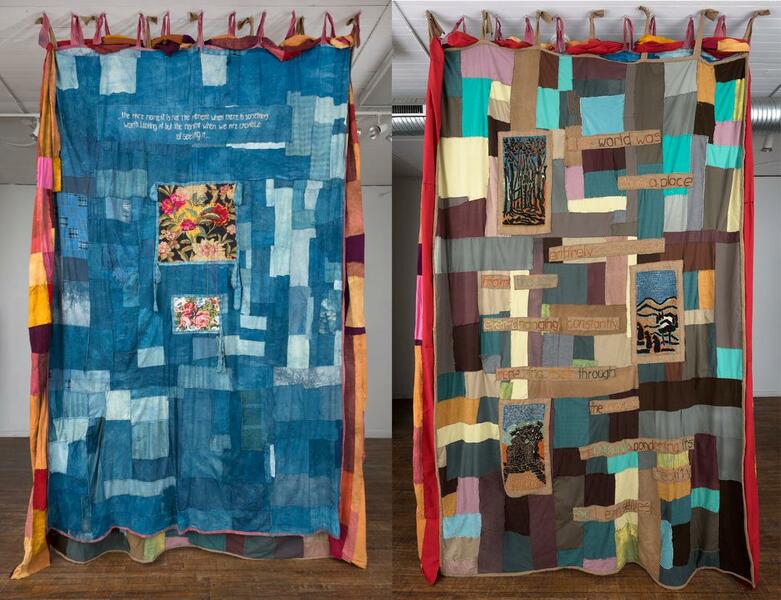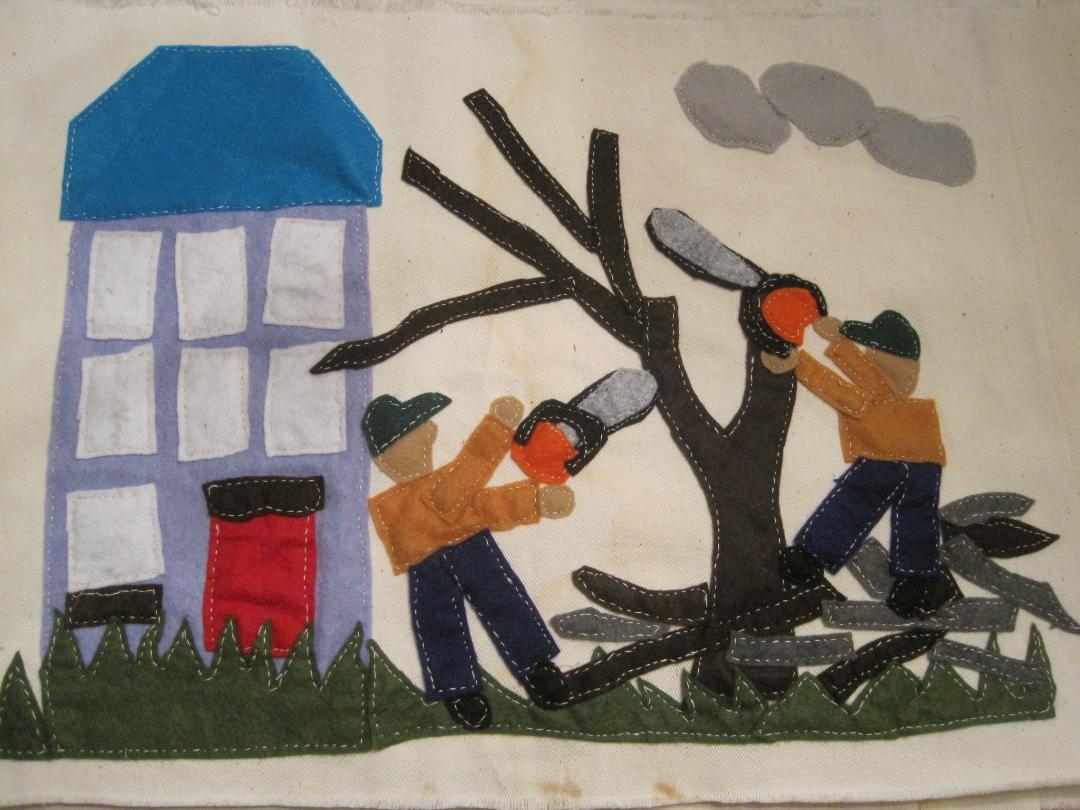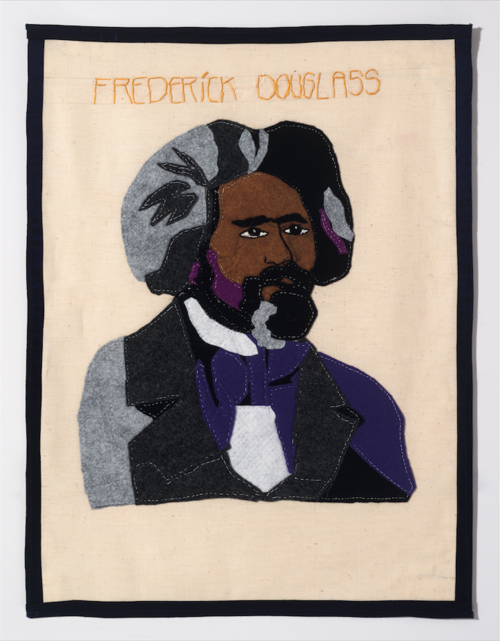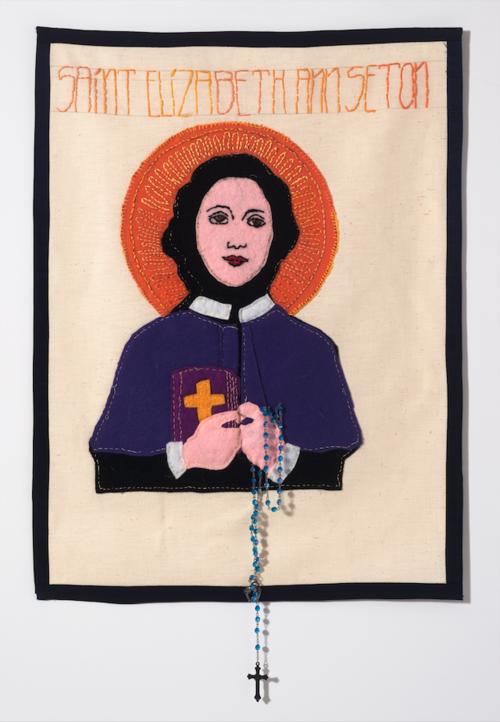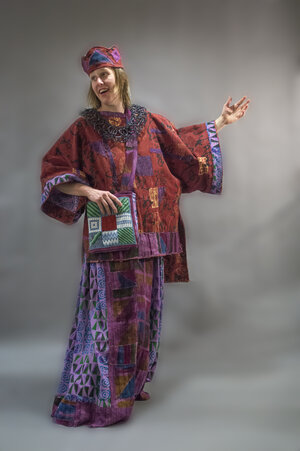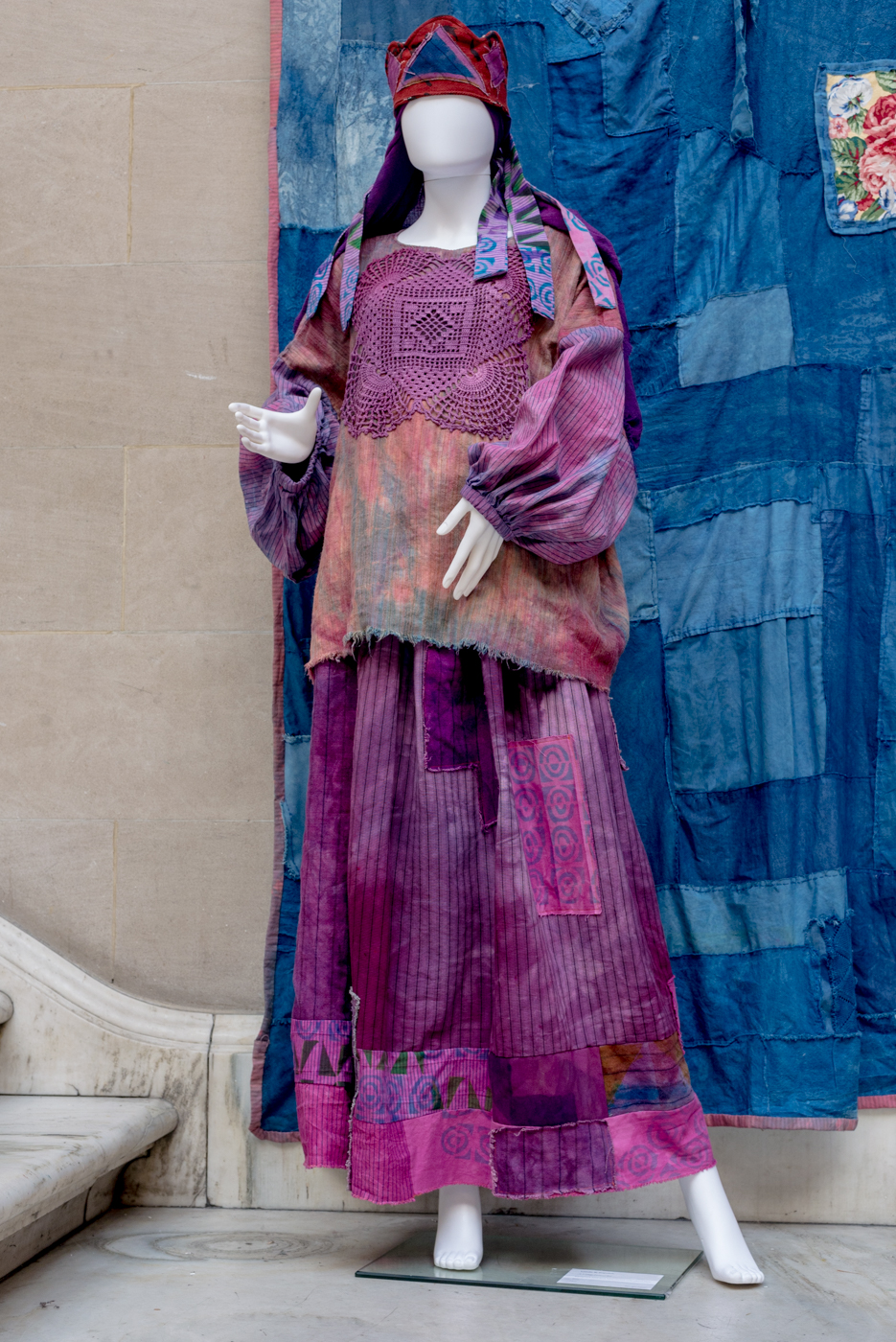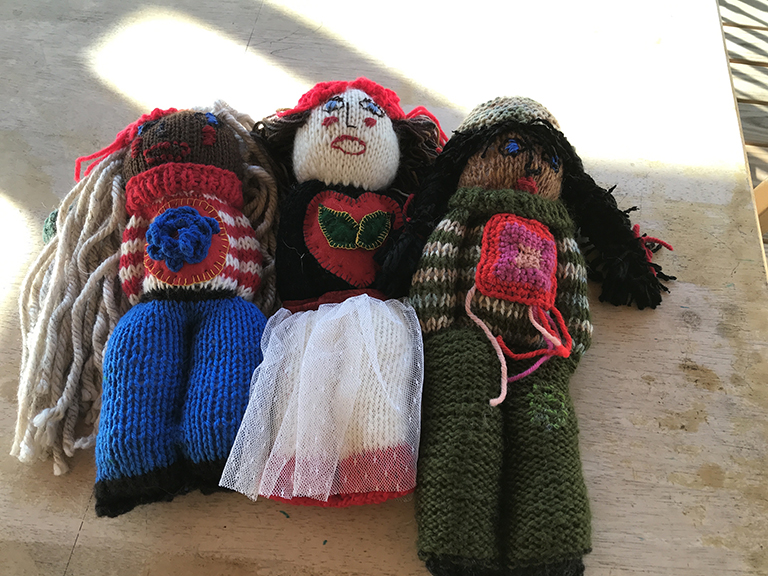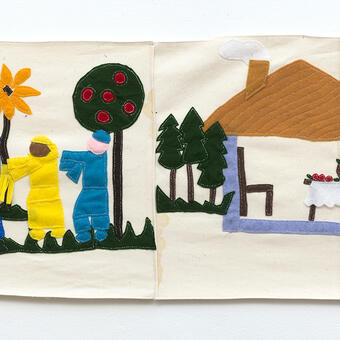Work samples
About Ursula
I was born during World War II and was raised by my widowed mother. Growing up during the war and in postwar Germany formed my character and made me accept challenges that ended sometimes with success but more often than not with defeat; both I accepted with equanimity. In 1979, after my husband’s death, I became addicted to prescription drugs and alcohol. I had a massive heart attack in 1981 but survived. It was then that I decided to change my life and that of my children. I chose to… more
Jump to a project:
Crankies
In my Crankie performances I am telling stories that are of interest to most people. These are stories from my own life, allegories and folk tales. A Crankie is an old storytelling art form. It is a long, illustrated scroll that is wound on two spools. The spools are loaded into a box which has a viewing window. The spools are hand-cranked (hence the name) while the story is told.
-
 The Song of A Tree: Screen 1This is the first screen of my Crankie, The Song of A Tree. This is the story of a tree that was cut down in my neighborhood. This inspired me to create a performative story about this tree's life. The imagery is made with repurposed material, which is hand-cut felt, hand-sewn to canvas.
The Song of A Tree: Screen 1This is the first screen of my Crankie, The Song of A Tree. This is the story of a tree that was cut down in my neighborhood. This inspired me to create a performative story about this tree's life. The imagery is made with repurposed material, which is hand-cut felt, hand-sewn to canvas. -
 The Song of A Tree: Screen 2This is the second screen of my Crankie, The Song of A Tree. This is the story of a tree that was cut down in my neighborhood, which inspired me to create a performative story about its life. The imagery is made with repurposed material, which is hand-cut felt, hand-sewn to canvas.
The Song of A Tree: Screen 2This is the second screen of my Crankie, The Song of A Tree. This is the story of a tree that was cut down in my neighborhood, which inspired me to create a performative story about its life. The imagery is made with repurposed material, which is hand-cut felt, hand-sewn to canvas. -
 The Song of A Tree: Screen 3This is the third screen of my Crankie, The Song of A Tree. This is the story of a tree that was cut down in my neighborhood, which inspired me to create a performative story about its life. The imagery is made with repurposed material, which is hand-cut felt, hand-sewn to canvas.
The Song of A Tree: Screen 3This is the third screen of my Crankie, The Song of A Tree. This is the story of a tree that was cut down in my neighborhood, which inspired me to create a performative story about its life. The imagery is made with repurposed material, which is hand-cut felt, hand-sewn to canvas. -
 The Story of MendingThis is my Crankie, The Story of Mending. It is an allegory combining the mending of clothes with the mending of interpersonal relationships. The imagery is made with repurposed material, which is hand-cut felt, hand-sewn to canvas.
The Story of MendingThis is my Crankie, The Story of Mending. It is an allegory combining the mending of clothes with the mending of interpersonal relationships. The imagery is made with repurposed material, which is hand-cut felt, hand-sewn to canvas.
The History of Baltimore
When I was invited to be part of a show at Maryland Art Place, I knew what I wanted to do: I wanted to pay tribute to my adopted hometown of Baltimore and its rich history. I dove into extensive research about its people and its places. I marveled at the lovely beginning when ‘Baltimore’ started out as a settlement of 25 houses. Learning which famous people walked its street, what had been forgotten of its captivating history in centuries and decades past, fascinated me. Baltimore even had its own hymn. Like the many things about this charmed city, it has been forgotten.
-
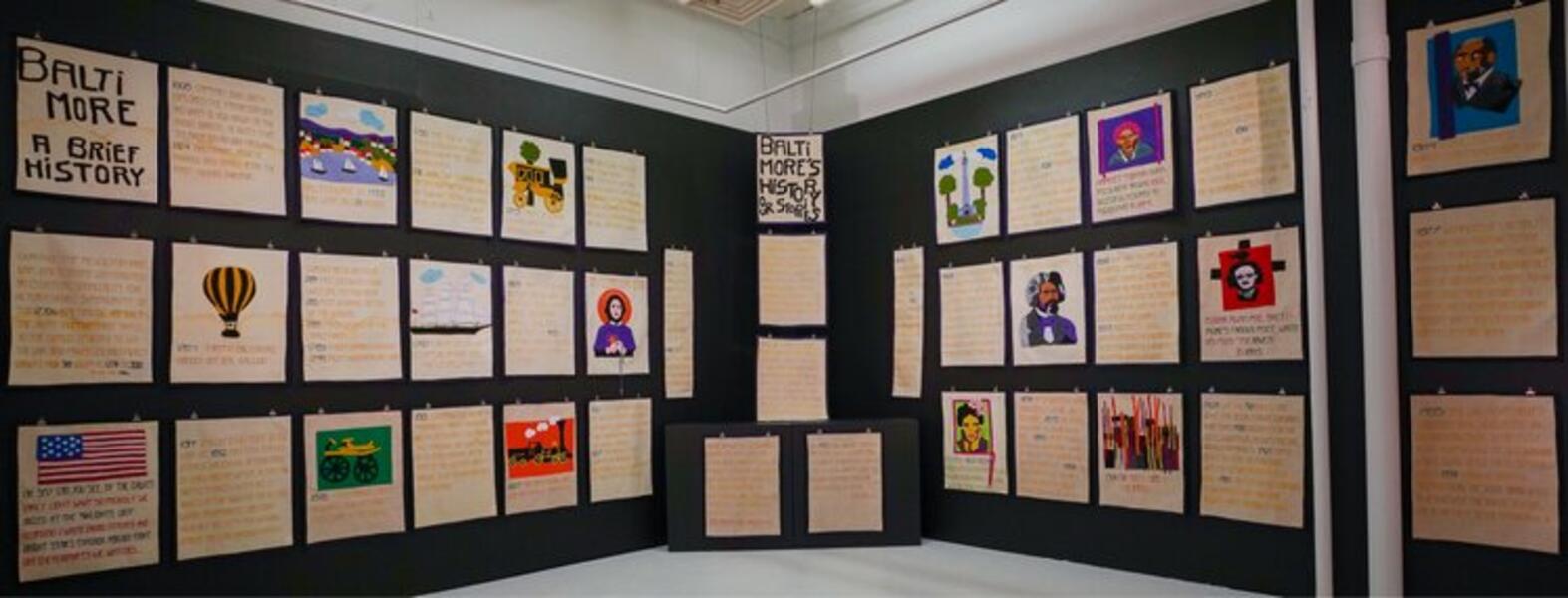 The History of BaltimoreWhen I was invited to be part of a show at Maryland Art Place, I knew what I wanted to do: I wanted to pay tribute to my adopted hometown of Baltimore and its rich history. I dove into extensive research about its people and its places. I marveled at the lovely beginning when ‘Baltimore’ started out as a settlement of 25 houses. Learning which famous people walked its street, what had been forgotten of its captivating history in centuries and decades past, fascinated me. Baltimore even had its own hymn. Like the many things about this charmed city, it has been forgotten.
The History of BaltimoreWhen I was invited to be part of a show at Maryland Art Place, I knew what I wanted to do: I wanted to pay tribute to my adopted hometown of Baltimore and its rich history. I dove into extensive research about its people and its places. I marveled at the lovely beginning when ‘Baltimore’ started out as a settlement of 25 houses. Learning which famous people walked its street, what had been forgotten of its captivating history in centuries and decades past, fascinated me. Baltimore even had its own hymn. Like the many things about this charmed city, it has been forgotten. -
 The History of Baltimore: Frederick DouglasWhen I was invited to be part of a show at Maryland Art Place, I knew what I wanted to do: I wanted to pay tribute to my adopted hometown of Baltimore and its rich history. I dove into extensive research about its people and its places. I marveled at the lovely beginning when ‘Baltimore’ started out as a settlement of 25 houses. Learning which famous people walked its street, what had been forgotten of its captivating history in centuries and decades past, fascinated me. Baltimore even had its own hymn. Like the many things about this charmed city, it has been forgotten.
The History of Baltimore: Frederick DouglasWhen I was invited to be part of a show at Maryland Art Place, I knew what I wanted to do: I wanted to pay tribute to my adopted hometown of Baltimore and its rich history. I dove into extensive research about its people and its places. I marveled at the lovely beginning when ‘Baltimore’ started out as a settlement of 25 houses. Learning which famous people walked its street, what had been forgotten of its captivating history in centuries and decades past, fascinated me. Baltimore even had its own hymn. Like the many things about this charmed city, it has been forgotten. -
 The History of Baltimore: Saint Elizabeth Ann SetonWhen I was invited to be part of a show at Maryland Art Place, I knew what I wanted to do: I wanted to pay tribute to my adopted hometown of Baltimore and its rich history. I dove into extensive research about its people and its places. I marveled at the lovely beginning when ‘Baltimore’ started out as a settlement of 25 houses. Learning which famous people walked its street, what had been forgotten of its captivating history in centuries and decades past, fascinated me. Baltimore even had its own hymn. Like the many things about this charmed city, it has been forgotten.
The History of Baltimore: Saint Elizabeth Ann SetonWhen I was invited to be part of a show at Maryland Art Place, I knew what I wanted to do: I wanted to pay tribute to my adopted hometown of Baltimore and its rich history. I dove into extensive research about its people and its places. I marveled at the lovely beginning when ‘Baltimore’ started out as a settlement of 25 houses. Learning which famous people walked its street, what had been forgotten of its captivating history in centuries and decades past, fascinated me. Baltimore even had its own hymn. Like the many things about this charmed city, it has been forgotten. -
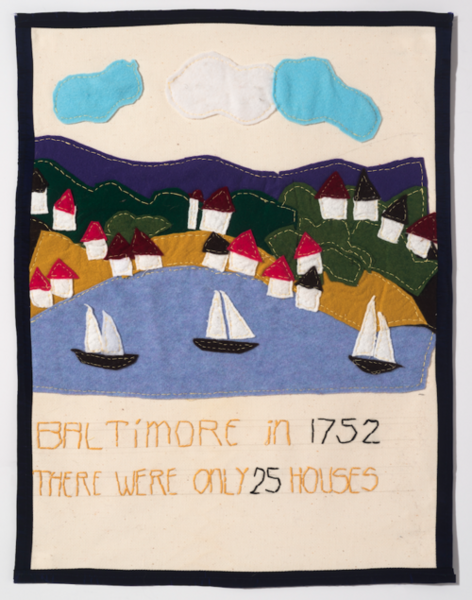 The History of Baltimore: 25 HousesWhen I was invited to be part of a show at Maryland Art Place, I knew what I wanted to do: I wanted to pay tribute to my adopted hometown of Baltimore and its rich history. I dove into extensive research about its people and its places. I marveled at the lovely beginning when ‘Baltimore’ started out as a settlement of 25 houses. Learning which famous people walked its street, what had been forgotten of its captivating history in centuries and decades past, fascinated me. Baltimore even had its own hymn. Like the many things about this charmed city, it has been forgotten.
The History of Baltimore: 25 HousesWhen I was invited to be part of a show at Maryland Art Place, I knew what I wanted to do: I wanted to pay tribute to my adopted hometown of Baltimore and its rich history. I dove into extensive research about its people and its places. I marveled at the lovely beginning when ‘Baltimore’ started out as a settlement of 25 houses. Learning which famous people walked its street, what had been forgotten of its captivating history in centuries and decades past, fascinated me. Baltimore even had its own hymn. Like the many things about this charmed city, it has been forgotten.
Embroideries
I love flowers. I love their beauty, their delicacy, their variety, but most of all their incredible richness in color and form. Real flowers fade away; mine retain their beauty forever.
-
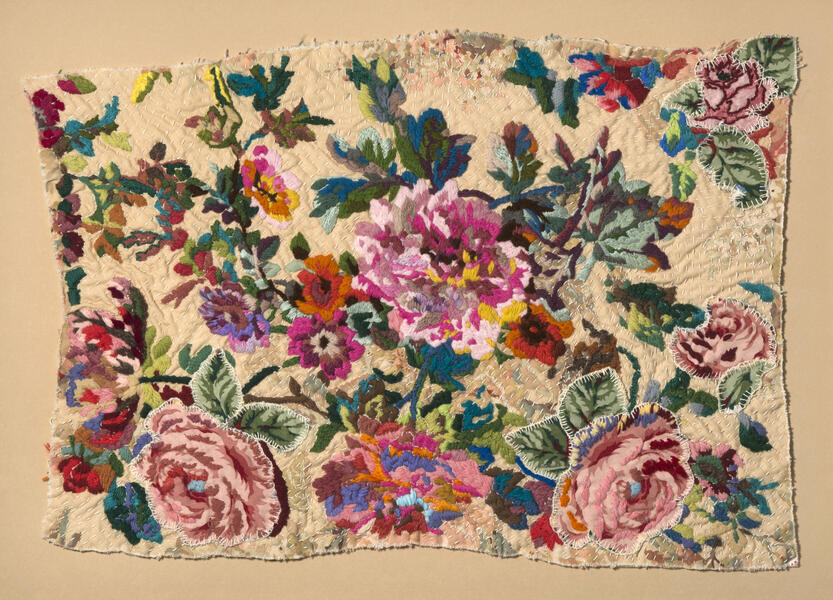 Salvaged RosesI love flowers. I love their beauty, their delicacy, their variety, but most of all their incredible richness in color and form. Real flowers fade away; mine retain their beauty forever.
Salvaged RosesI love flowers. I love their beauty, their delicacy, their variety, but most of all their incredible richness in color and form. Real flowers fade away; mine retain their beauty forever. -
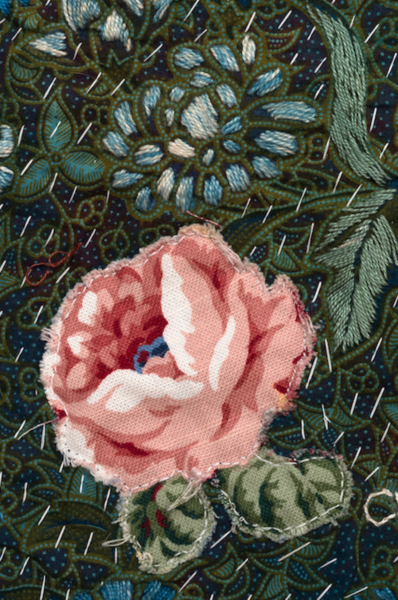 A Rose is A Rose is A RoseI love flowers. I love their beauty, their delicacy, their variety, but most of all their incredible richness in color and form. Real flowers fade away; mine retain their beauty forever.
A Rose is A Rose is A RoseI love flowers. I love their beauty, their delicacy, their variety, but most of all their incredible richness in color and form. Real flowers fade away; mine retain their beauty forever. -
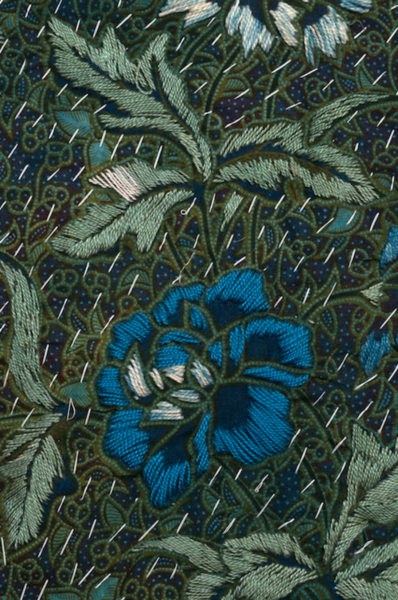 The Blue Flower of DreamsI love flowers. I love their beauty, their delicacy, their variety, but most of all their incredible richness in color and form. Real flowers fade away; mine retain their beauty forever.
The Blue Flower of DreamsI love flowers. I love their beauty, their delicacy, their variety, but most of all their incredible richness in color and form. Real flowers fade away; mine retain their beauty forever. -
 My Heart's DesireI love flowers. I love their beauty, their delicacy, their variety, but most of all their incredible richness in color and form. Real flowers fade away; mine retain their beauty forever.
My Heart's DesireI love flowers. I love their beauty, their delicacy, their variety, but most of all their incredible richness in color and form. Real flowers fade away; mine retain their beauty forever.
Dreams of Tartary
Tartary or Great Tartary was a historical region in
Asia located between the Caspian Sea-Ural
Mountains and the Pacific Ocean. Tartary was a
blanket term used by Europeans for the areas of
Central Asia, North Asia, and East Asia unknown
to European geography.
In my childhood, in the early 1940s, when there
was nothing available to make new clothes, make
something less drab, I encountered at the
outskirts of our small medieval town in Germany a
camp of Romas or Nomads. When I saw the
sweeping skirts of the women, colorful and
beautiful, I was forever captivated by this type of
clothes. I am reliving the impact these dresses
had on my young mind when I create my
costumes. They are –so I hope- as colorful and
sweeping as those I saw so many years ago.
-
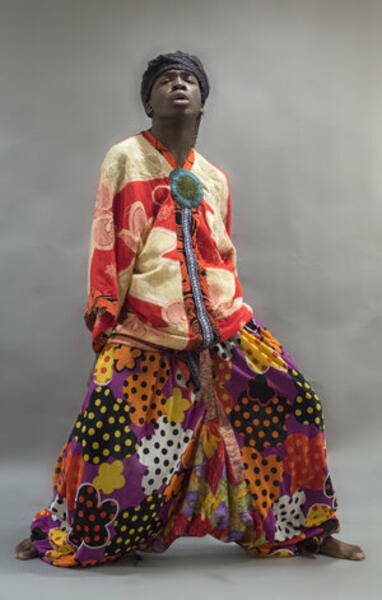 The Nomad KingTartary or Great Tartary was a historical region in Asia located between the Caspian Sea-Ural Mountains and the Pacific Ocean. Tartary was a blanket term used by Europeans for the areas of Central Asia, North Asia, and East Asia unknown to European geography. In my childhood, in the early 1940s, when there was nothing available to make new clothes, make something less drab, I encountered at the outskirts of our small medieval town in Germany a camp of Romas or Nomads. When I saw the sweeping skirts of the women, colorful and beautiful, I was forever captivated by this type of clothes. I am reliving the impact these dresses had on my young mind when I create my costumes. They are –so I hope- as colorful and sweeping as those I saw so many years ago.
The Nomad KingTartary or Great Tartary was a historical region in Asia located between the Caspian Sea-Ural Mountains and the Pacific Ocean. Tartary was a blanket term used by Europeans for the areas of Central Asia, North Asia, and East Asia unknown to European geography. In my childhood, in the early 1940s, when there was nothing available to make new clothes, make something less drab, I encountered at the outskirts of our small medieval town in Germany a camp of Romas or Nomads. When I saw the sweeping skirts of the women, colorful and beautiful, I was forever captivated by this type of clothes. I am reliving the impact these dresses had on my young mind when I create my costumes. They are –so I hope- as colorful and sweeping as those I saw so many years ago. -
 The Tribal QueenTartary or Great Tartary was a historical region in Asia located between the Caspian Sea-Ural Mountains and the Pacific Ocean. Tartary was a blanket term used by Europeans for the areas of Central Asia, North Asia, and East Asia unknown to European geography. In my childhood, in the early 1940s, when there was nothing available to make new clothes, make something less drab, I encountered at the outskirts of our small medieval town in Germany a camp of Romas or Nomads. When I saw the sweeping skirts of the women, colorful and beautiful, I was forever captivated by this type of clothes. I am reliving the impact these dresses had on my young mind when I create my costumes. They are –so I hope- as colorful and sweeping as those I saw so many years ago.
The Tribal QueenTartary or Great Tartary was a historical region in Asia located between the Caspian Sea-Ural Mountains and the Pacific Ocean. Tartary was a blanket term used by Europeans for the areas of Central Asia, North Asia, and East Asia unknown to European geography. In my childhood, in the early 1940s, when there was nothing available to make new clothes, make something less drab, I encountered at the outskirts of our small medieval town in Germany a camp of Romas or Nomads. When I saw the sweeping skirts of the women, colorful and beautiful, I was forever captivated by this type of clothes. I am reliving the impact these dresses had on my young mind when I create my costumes. They are –so I hope- as colorful and sweeping as those I saw so many years ago. -
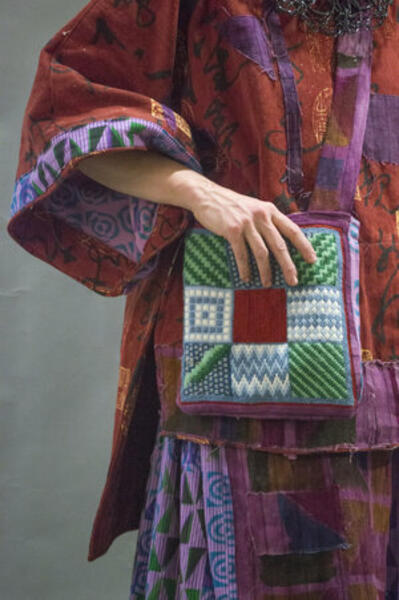 The Tribal Queen: Handbag detailTartary or Great Tartary was a historical region in Asia located between the Caspian Sea-Ural Mountains and the Pacific Ocean. Tartary was a blanket term used by Europeans for the areas of Central Asia, North Asia, and East Asia unknown to European geography. In my childhood, in the early 1940s, when there was nothing available to make new clothes, make something less drab, I encountered at the outskirts of our small medieval town in Germany a camp of Romas or Nomads. When I saw the sweeping skirts of the women, colorful and beautiful, I was forever captivated by this type of clothes. I am reliving the impact these dresses had on my young mind when I create my costumes. They are –so I hope- as colorful and sweeping as those I saw so many years ago.
The Tribal Queen: Handbag detailTartary or Great Tartary was a historical region in Asia located between the Caspian Sea-Ural Mountains and the Pacific Ocean. Tartary was a blanket term used by Europeans for the areas of Central Asia, North Asia, and East Asia unknown to European geography. In my childhood, in the early 1940s, when there was nothing available to make new clothes, make something less drab, I encountered at the outskirts of our small medieval town in Germany a camp of Romas or Nomads. When I saw the sweeping skirts of the women, colorful and beautiful, I was forever captivated by this type of clothes. I am reliving the impact these dresses had on my young mind when I create my costumes. They are –so I hope- as colorful and sweeping as those I saw so many years ago. -
 Nomad's DreamTartary or Great Tartary was a historical region in Asia located between the Caspian Sea-Ural Mountains and the Pacific Ocean. Tartary was a blanket term used by Europeans for the areas of Central Asia, North Asia, and East Asia unknown to European geography. In my childhood, in the early 1940s, when there was nothing available to make new clothes, make something less drab, I encountered at the outskirts of our small medieval town in Germany a camp of Romas or Nomads. When I saw the sweeping skirts of the women, colorful and beautiful, I was forever captivated by this type of clothes. I am reliving the impact these dresses had on my young mind when I create my costumes. They are –so I hope- as colorful and sweeping as those I saw so many years ago.
Nomad's DreamTartary or Great Tartary was a historical region in Asia located between the Caspian Sea-Ural Mountains and the Pacific Ocean. Tartary was a blanket term used by Europeans for the areas of Central Asia, North Asia, and East Asia unknown to European geography. In my childhood, in the early 1940s, when there was nothing available to make new clothes, make something less drab, I encountered at the outskirts of our small medieval town in Germany a camp of Romas or Nomads. When I saw the sweeping skirts of the women, colorful and beautiful, I was forever captivated by this type of clothes. I am reliving the impact these dresses had on my young mind when I create my costumes. They are –so I hope- as colorful and sweeping as those I saw so many years ago. -
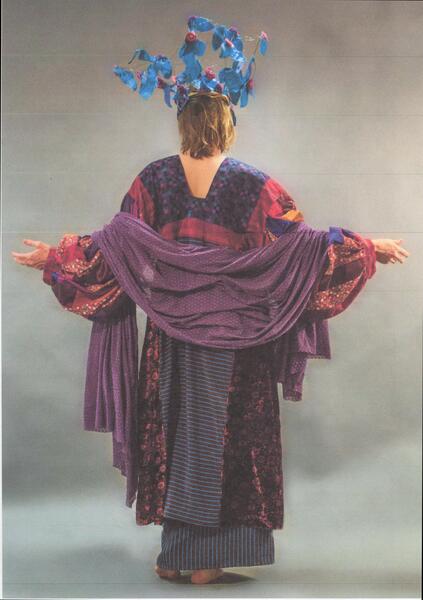 The Tribal Queen: HeaddressTartary or Great Tartary was a historical region in Asia located between the Caspian Sea-Ural Mountains and the Pacific Ocean. Tartary was a blanket term used by Europeans for the areas of Central Asia, North Asia, and East Asia unknown to European geography. In my childhood, in the early 1940s, when there was nothing available to make new clothes, make something less drab, I encountered at the outskirts of our small medieval town in Germany a camp of Romas or Nomads. When I saw the sweeping skirts of the women, colorful and beautiful, I was forever captivated by this type of clothes. I am reliving the impact these dresses had on my young mind when I create my costumes. They are –so I hope- as colorful and sweeping as those I saw so many years ago.
The Tribal Queen: HeaddressTartary or Great Tartary was a historical region in Asia located between the Caspian Sea-Ural Mountains and the Pacific Ocean. Tartary was a blanket term used by Europeans for the areas of Central Asia, North Asia, and East Asia unknown to European geography. In my childhood, in the early 1940s, when there was nothing available to make new clothes, make something less drab, I encountered at the outskirts of our small medieval town in Germany a camp of Romas or Nomads. When I saw the sweeping skirts of the women, colorful and beautiful, I was forever captivated by this type of clothes. I am reliving the impact these dresses had on my young mind when I create my costumes. They are –so I hope- as colorful and sweeping as those I saw so many years ago.
Spindelpueppchen: Art Dolls
These little dolls are a reminiscence of my early childhood during World War II and of the years of the 1940’s. It was a time of destitution in Germany. There was just nothing available, neither food nor anything else. My mother tried to get us through these times by knitting sweaters for some kind of cottage industry. She received the yarn and a pittance for the finished product. I sat next to her and learned knitting by watching her. From some of the leftover yarn she made these little dolls for me. I gave them names, and thought of them as my playmates. I loved them; they were all I knew.
-
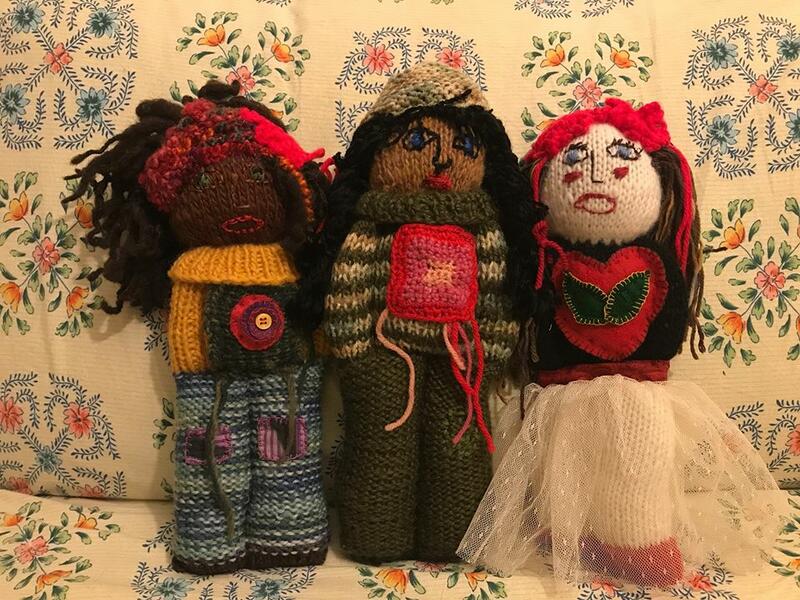 Spindelpueppchen: Art DollsThese little dolls are a reminiscence of my early childhood during World War II and of the years of the 1940’s. It was a time of destitution in Germany. There was just nothing available, neither food nor anything else. My mother tried to get us through these times by knitting sweaters for some kind of cottage industry. She received the yarn and a pittance for the finished product. I sat next to her and learned knitting by watching her. From some of the leftover yarn she made these little dolls for me. I gave them names, and thought of them as my playmates. I loved them; they were all I knew.
Spindelpueppchen: Art DollsThese little dolls are a reminiscence of my early childhood during World War II and of the years of the 1940’s. It was a time of destitution in Germany. There was just nothing available, neither food nor anything else. My mother tried to get us through these times by knitting sweaters for some kind of cottage industry. She received the yarn and a pittance for the finished product. I sat next to her and learned knitting by watching her. From some of the leftover yarn she made these little dolls for me. I gave them names, and thought of them as my playmates. I loved them; they were all I knew. -
 Spindelpueppchen: Art DollsThese little dolls are a reminiscence of my early childhood during World War II and of the years of the 1940’s. It was a time of destitution in Germany. There was just nothing available, neither food nor anything else. My mother tried to get us through these times by knitting sweaters for some kind of cottage industry. She received the yarn and a pittance for the finished product. I sat next to her and learned knitting by watching her. From some of the leftover yarn she made these little dolls for me. I gave them names, and thought of them as my playmates. I loved them; they were all I knew.
Spindelpueppchen: Art DollsThese little dolls are a reminiscence of my early childhood during World War II and of the years of the 1940’s. It was a time of destitution in Germany. There was just nothing available, neither food nor anything else. My mother tried to get us through these times by knitting sweaters for some kind of cottage industry. She received the yarn and a pittance for the finished product. I sat next to her and learned knitting by watching her. From some of the leftover yarn she made these little dolls for me. I gave them names, and thought of them as my playmates. I loved them; they were all I knew. -
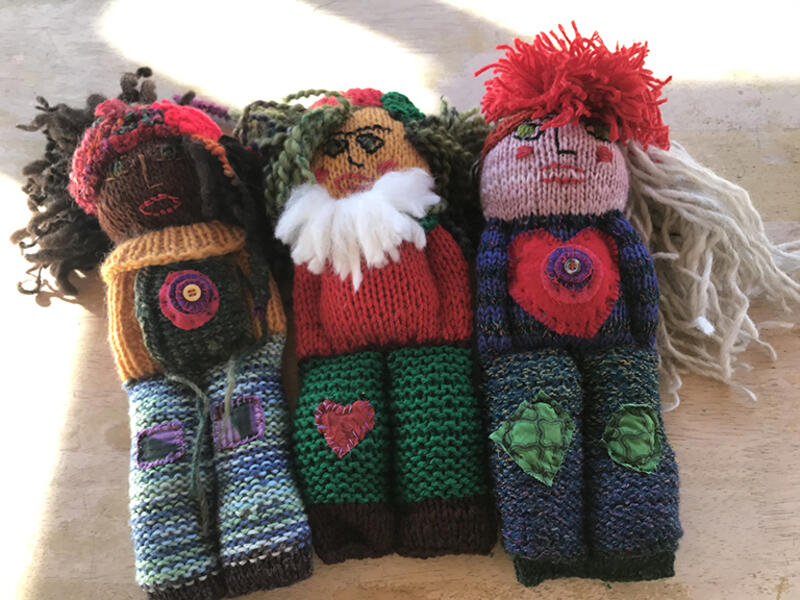 Spindelpueppchen: Art DollsThese little dolls are a reminiscence of my early childhood during World War II and of the years of the 1940’s. It was a time of destitution in Germany. There was just nothing available, neither food nor anything else. My mother tried to get us through these times by knitting sweaters for some kind of cottage industry. She received the yarn and a pittance for the finished product. I sat next to her and learned knitting by watching her. From some of the leftover yarn she made these little dolls for me. I gave them names, and thought of them as my playmates. I loved them; they were all I knew.
Spindelpueppchen: Art DollsThese little dolls are a reminiscence of my early childhood during World War II and of the years of the 1940’s. It was a time of destitution in Germany. There was just nothing available, neither food nor anything else. My mother tried to get us through these times by knitting sweaters for some kind of cottage industry. She received the yarn and a pittance for the finished product. I sat next to her and learned knitting by watching her. From some of the leftover yarn she made these little dolls for me. I gave them names, and thought of them as my playmates. I loved them; they were all I knew. -
 Spindelpueppchen: Art DollsThese little dolls are a reminiscence of my early childhood during World War II and of the years of the 1940’s. It was a time of destitution in Germany. There was just nothing available, neither food nor anything else. My mother tried to get us through these times by knitting sweaters for some kind of cottage industry. She received the yarn and a pittance for the finished product. I sat next to her and learned knitting by watching her. From some of the leftover yarn she made these little dolls for me. I gave them names, and thought of them as my playmates. I loved them; they were all I knew.
Spindelpueppchen: Art DollsThese little dolls are a reminiscence of my early childhood during World War II and of the years of the 1940’s. It was a time of destitution in Germany. There was just nothing available, neither food nor anything else. My mother tried to get us through these times by knitting sweaters for some kind of cottage industry. She received the yarn and a pittance for the finished product. I sat next to her and learned knitting by watching her. From some of the leftover yarn she made these little dolls for me. I gave them names, and thought of them as my playmates. I loved them; they were all I knew. -
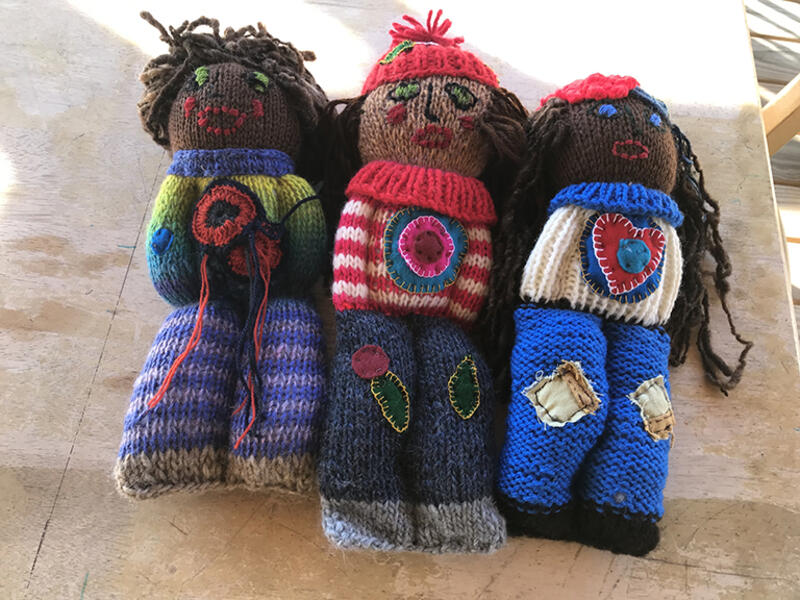 Spindelpueppchen: Art DollsThese little dolls are a reminiscence of my early childhood during World War II and of the years of the 1940’s. It was a time of destitution in Germany. There was just nothing available, neither food nor anything else. My mother tried to get us through these times by knitting sweaters for some kind of cottage industry. She received the yarn and a pittance for the finished product. I sat next to her and learned knitting by watching her. From some of the leftover yarn she made these little dolls for me. I gave them names, and thought of them as my playmates. I loved them; they were all I knew.
Spindelpueppchen: Art DollsThese little dolls are a reminiscence of my early childhood during World War II and of the years of the 1940’s. It was a time of destitution in Germany. There was just nothing available, neither food nor anything else. My mother tried to get us through these times by knitting sweaters for some kind of cottage industry. She received the yarn and a pittance for the finished product. I sat next to her and learned knitting by watching her. From some of the leftover yarn she made these little dolls for me. I gave them names, and thought of them as my playmates. I loved them; they were all I knew.
